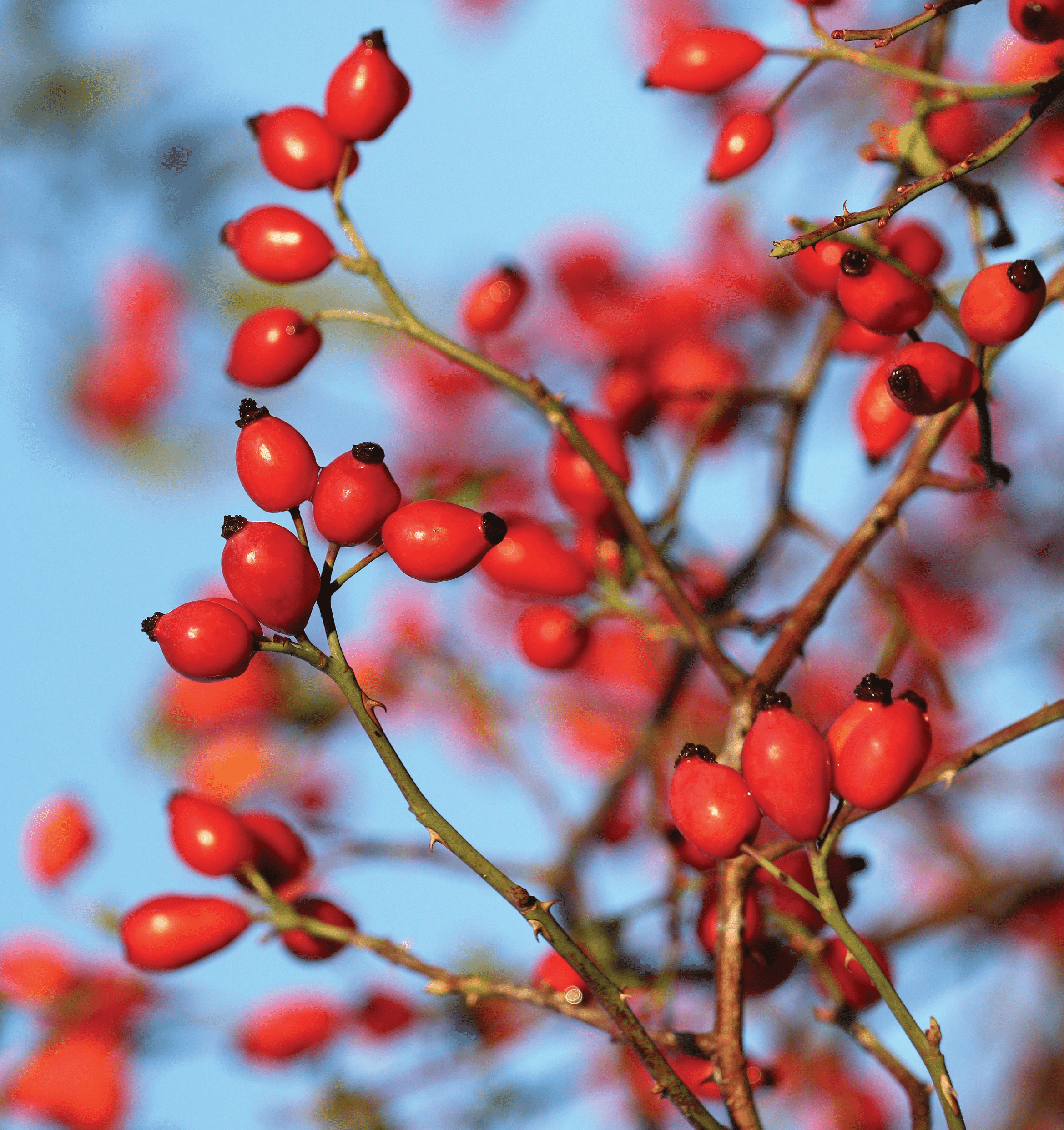Rosehips, Latin name, Rosa canina, can be found growing on wild rose bushes. They are the bright, red to orange oval shaped fruits, most commonly found in hedgerows. As autumn sets in and the first frosts touch the land, the berries are ready to be harvested, as the frost softens the berry and makes it sweeter. While they might look similar to hawthorn berries, it’s important not to confuse the two as hawthorn should only be consumed under the supervision of a qualified Herbal Practitioner. Use a good Plant Identifier Book to make sure you have the correct berry
Rosehips have their distinct properties and uses that make them unique treasures in the world of natural remedies and are accessible to all of us.
Sharing: Remember the Birds
As you harvest rosehips, don’t forget that we’re not the only ones who appreciate them! Birds, such as thrushes and finches, rely on these tough little fruits as a vital food source during the colder months. Their firm skin protects the fruit like a store cupboard, providing a supply for the birds. They expertly peck at the rosehips, drawing out the sustenance they need during the winter. When foraging for your own use, be sure to leave some behind so that our feathered friends can also enjoy the bounty nature provides.
Powerful Nutrients
Rosehips are packed with vitamin C, even more so than oranges in some cases. This powerful antioxidant plays a crucial role in boosting immunity, supporting skin health, and aiding in the absorption of iron. Besides vitamin C, rosehips contain beneficial compounds like flavonoids and carotenoids that contribute to overall wellness.
History: Rosehips During Wartime
Rosehips have been celebrated for centuries, but their value truly came to the forefront during World War II. With citrus fruits, thus a supply of Vitamin C being scarce due to wartime shortages, rosehips became a vital source of vitamin C for the British population. Children and families would gather these small fruits to make syrups and tonics that provided essential nutrients to support their health during what must have been very challenging times.
Personal Memories of Harvesting Rosehips
One of my earliest memories of harvesting rosehips is venturing out into the hedgerows as the coolness of autumn set in. I remember the leaves crunching under my feet and the air crisp with frost. The rosehips were tricky little things though; they didn’t give themselves up easily! First, there was the task of avoiding the sharp thorns of the wild rose bushes. My fingers had to become nimble, and I had to learn how to pick each hip delicately without leaving behind a mass of scratches on my hands.
The real work though began at home, with rosehips spread across the kitchen table. It was here that their true toughness became apparent. To process them, I’d need to carefully chop them up that required a sharp knife and an even sharper sense of caution. The first lesson rosehips taught me was patience. Each tiny fruit held a treasure of vitamin C and other goodness, but only if you approached them with care and attentiveness. I remember my mother’s voice reminding me, “Watch your fingers,” as I worked away, trying to turn those berries into syrup that we could use during the cold winter months.
Processing Rosehips: Tips and Techniques
Processing rosehips begins with careful harvesting and preparation. Always rinse them thoroughly and trim off the stems and ends. When working with rosehips, be cautious of their tiny, hair-like seeds, as they can be irritating if ingested.
Drying Rosehips
Preparation: Slice the rosehips in half and remove as many seeds as possible.
Drying Method: Lay the prepared rosehips on a baking sheet and place them in an oven at a low temperature (around 100°C or 212°F) for several hours, or until they are fully dried. Alternatively, use a dehydrator if you have one.
Storage: Store the dried rosehips in an airtight container in a cool, dark place for up to a year.
ROSEHIP RECIPES
Rosehip Infused Oil
This oil can be used as a nourishing skin treatment.
Ingredients:
- 1 cup dried rosehips
- 1.5 cups carrier oil (e.g., olive oil or sunflower oil)
Instructions:
- Place the dried rosehips in a clean glass jar.
- Cover with the oil, ensuring the rosehips are fully submerged.
- Seal the jar and let it infuse in a warm spot for 2 to 4 weeks. Shake it gently every few days to increase the potency of the infusion.
- Strain the oil through a cheesecloth or fine strainer, and store in a dark glass bottle.
Rosehip Tea
A warm, vitamin-rich tea perfect for cosy evenings.
Ingredients:
- 2 tbsp dried rosehips (or 4 tbsp fresh)
- 2 cups boiling water
Instructions:
- Place the rosehips in a teapot or heat proof jar.
- Pour boiling water over them and let steep for 15-20 minutes.
- Strain and enjoy as is or with a touch of honey for sweetness.
Rosehip Syrup
A classic Vitamin C packed, immune-boosting syrup with a sweet and tangy flavour.
Ingredients:
- 500g fresh rosehips
- 1 litre water
- 500g granulated sugar
- Juice of 1 lemon
Instructions:
- Rinse and chop the rosehips, removing as many seeds as possible.
- Boil the water in a large saucepan, add the rosehips, and simmer for 20 minutes.
- Remove from heat and let it steep for another 20 minutes.
- Strain through a muslin cloth or fine sieve to remove the pulp and seeds.
- Return the liquid to the pan, add the sugar, and stir until dissolved over low heat.
- Simmer for an additional 5-10 minutes, then stir in the lemon juice.
- Pour into sterilised bottles and seal.
Cherishing Nature’s Gifts
Rosehips remind us of the simple yet powerful gifts of nature. Whether infused into oil for your skincare, steeped for a soothing tea, or simmered into syrup for a health boost, these little fruits carry history, health, and natural goodness in every bite.
As you harvest and use them, remember to share this gift with the birds and other wildlife, leaving some behind for all to cherish.
Cautions:
- Harvest responsibly—leave some berries for the birds and other wildlife.
- Avoid harvesting from areas exposed to pollution, such as busy roadsides.
- Ensure you are picking rosehips and not a similar plant by using a reliable plant identification guide.
- Always ask the landowner for permission before foraging.
- Wild Rose have thorns so wear gloves to avoid being scratched.

